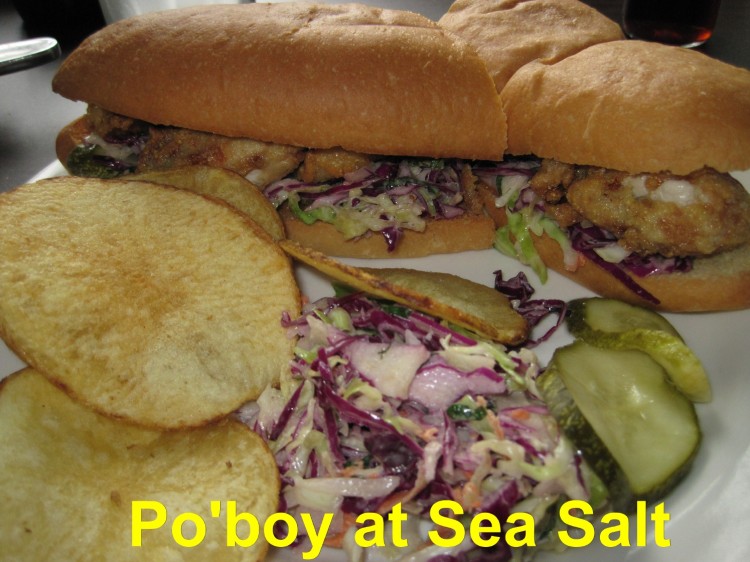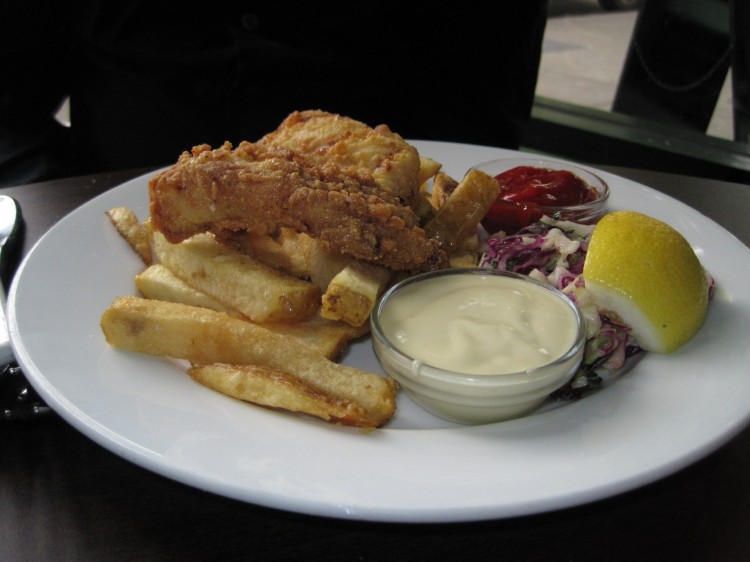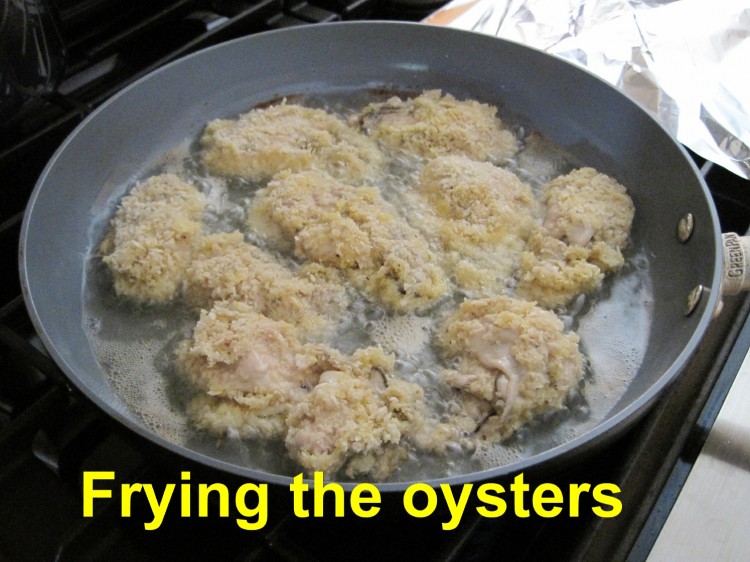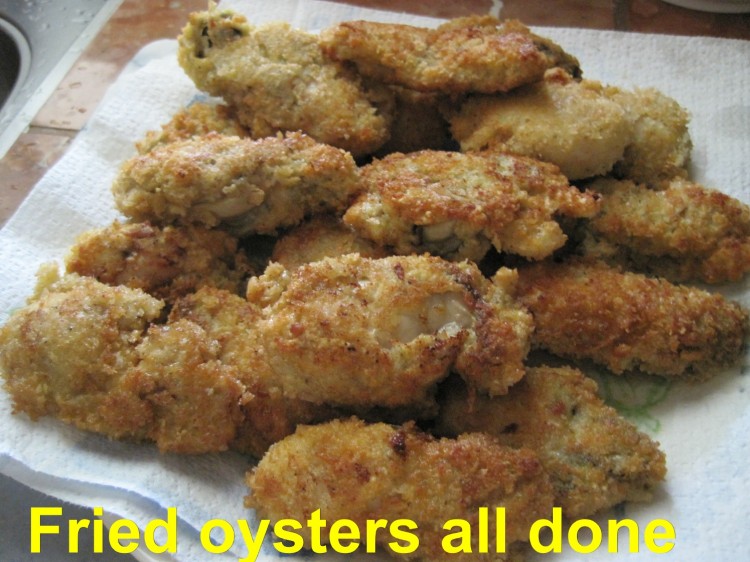
I admit to craving oysters every now and then. I would have been happy in turn-of-the-century New York City, I think, where oysters were plentiful and every dive sold oyster stew.
I often see an oyster po’boy—or poor boy, if you want to get fancy—in my mind’s eye as I’m driving or doing laundry. I never know when a strong desire for fried oysters will strike.
The bread in my po’boy fantasy is always an Acme sourdough roll. The oysters are always large, plump and juicy — and there are so many of them they are falling out of the sandwich. The breading on these fried pillows of bliss is a little crunchy and has some spice, but not enough to mask that hint of metallic funkiness. There are slices of the tomatoes I had as a child – huge, red, ripe Beefsteaks from roadside stands in New Jersey and Pennsylvania. A little cabbage slaw barely dressed in a sweet-sour dressing peeks out, and there might even be a little remoulade, if I’m getting really unhinged.
As you can see, to me, a po’boy is made with fried oysters. Period. Even though this Louisiana sandwich is perfectly authentic made with other kinds of fried seafood, or even meat, I figure I can have those things any old time. Fried oysters make it special.
Believe it or not, it’s the bread that defines a po’boy. Apparently there is such a thing as Louisiana French bread – something like a baguette – with a flaky exterior and a soft interior. Perhaps this is like banh mi – a Vietnamese baguette. I’ve never had a po’boy in its native habitat, so I don’t know, but I have some time yet.

Matthew at Sea Salt restaurant in Berkeley
The long and short of this story involves Matthew, my son, and myself driving down San Pablo Avenue one day deciding to pop in to Sea Salt (2512 San Pablo Avenue, Berkeley) for a po’boy pour moi and fish and chips for his nibs.
Sea Salt is a solid seafood restaurant. I like the fact that they preserve the authenticity of standards like fish and chips and clam chowder. God knows there are enough places in Northern Cali where these things have been deconstructed and reinvented to death.
It ain’t cheap, being an upscale member of the K2 family of eating establishments, which includes Jimmy Beans, Fonda, T-Rex and LaLime’s.
That said, $14 is a small price to pay for your heart’s desire – served in a very nice space with great service, to boot. My po’boy came on a quality roll with slaw and remoulade, and housed a respectable number of oysters. Oh, man, the oysters were good. Not only perfectly cooked, but fresh, given that they were shucking oysters in the kitchen while we were there eating. The breading had texture and flavor, too. Suffice it to say that the whole damned sandwich was slammin’.
I have to mention the hand-cut, house-made potato chips. They were the thickest pototo chips I ever had in a restaurant, and not at all greasy. Crunchy and salty, they were terrific.
Matt’s $14 fish and chips plate was fine, if a bit skimpy in the fish department, but the quality was there. The cod was fresh and nicely cooked. Matt said he’d get the po’boy next time, though.

Fish and Chips at Sea Salt restaurant in Berkeley
I think you should try your hand at a po’boy at home. It can be a bit messsy, and it’s easy to overcook oysters, but the result will be worth it – even if you have to try a couple of times before you nail the oyster-frying process.
If you want to shuck your own oysters, great. I do not. I buy them from a fishmonger who will shuck them for me, or I’ll pick up a high quality, fresh, jarred oyster. Look for sustainably-farmed, and ask your fish guy or gal which local oyster they recommend for po’boys. Make sure you buy oysters at a reputable shop. The last thing you want is food-borne illness from a shady oyster.

Po’boy at chez akitachow
Basic Po’boy
1 quart medium-sized fresh oysters (medium is nice and large – small is OK if this is all you can find)
3/4 cup flour
1 teaspoon Old Bay seasoning
1 teaspoon Kosher salt
1/2 teaspoon black pepper
1/2 teaspoon ground mustard
1/4 teaspoon cayenne pepper
1 – 1/2 cups panko (coarse bread crumbs)
1 teaspoon Kosher salt
3 eggs, scrambled with 2 tablespoons water
2 large, ripe, tomatoes, sliced or diced. Use really good tomatoes or leave them out of the recipe!
Canola oil for frying
5 long rolls of some kind. I like Acme sweet or sour rolls. Use good rolls here!
If you have a large, cast-iron frying pan, this would be a good time to haul it out
1). Whisk together flour, Old Bay, salt, black pepper, ground mustard and cayenne pepper in medium-sized bowl. Set aside.
2). Combine panko and salt in medium-sized bowl. Set aside.
3). Carefully – very carefully! – pour your oysters into a bowl. No need to rinse them – just feel around gently for stray shell pieces. I do this by catching each oyster as it transitions from jar to bowl.
4). Arrange your breading station: oysters, flour, egg mixture, panko mixture, receiving plate.
5). Set up a large, heavy-guage, frying pan with about a 1/2 inch of Canola oil on your burner – but don’t turn on the flame yet.
6). Set out a small sheet pan lined with paper towels to place fried oysters on, as well as long tongs.
7). Set out your plates – place a split roll on each and have your slaw on stand-by.
8). Bread oysters like so: Add four oysters to your flour mix, allowing juices to drain through your fingers first. Toss gently. Move with dry hand into egg mixture, and coat evenly. Move to panko, toss gently to coat, and move with dry hand to plate. It’s hard to do the ‘wet hand, dry hand’ thing here, but see if you can keep one hand dry to move coated oysters around.
9). When you are all ready, turn on a medium flame under your frying pan and let the oil get hot. Toss in a couple crumbs of panko to see if there’s a sizzle.
10). Gently add oysters (carefully, by hand, because they will be floppy) so you do not crowd them and thus wind up bringing the temperature of the oil down. You want them to sizzle but not burn.
11). Once they have browned a bit, turn them over gently with the tongs and let them quickly brown on the other side.
12). Get them out of the pan and onto your sheet pan as soon as you’ve done this. If you overcook them, they will shrink and become rubbery. They do not need more than a few minutes over the heat.
13). Bring oil back up to proper heat (add a little more oil if you need to) and repeat with remaining oysters.
14). As soon as your last oyster hits the sheet pan, prep the rolls for the oysters.
15). Arrange tomato slices in each roll and then heap a nice mound of slaw on top.
16). Add 4 – 5 oysters on top and serve right away with lots of napkins! I put the oysters on top of the wet stuff so they don’t get soggy.
Slaw for Po’boys
Makes enough for about 5 large sandwiches
2 1/2 tablespoons white vinegar
2 tablespoons sugar
1/4 cup good mayonnaise (see my post on this)
1/2 teaspoon Dijon mustard
A little salt & pepper
1 pound shredded cabbage or cole slaw mix
1). Whisk everything but the cabbage together in a bowl until the sugar is dissolved.
2). Fold in cabbage well.
3). Leave on counter for an hour, folding the mass together every so often.
4). Place in fridge until ready to use.
If you want to serve a remoulade*, there are many recipes on the web, but you can’t go wrong mixing a little chili oil, white pepper and salt into some good mayo.
*A remoulade is often something like thousand island dressing, but it can also be akin to tartar sauce, depending upon the recipe.



Oh I will have to try this…Looks so good:)
Thanks! Oh, yeah, this is a real treat if you like oysters!!!